#cleopatra philopator
Explore tagged Tumblr posts
Text
My favorite Cleopatra in Space Character is Cleopatra Philopator VII!
The Space Princess of Egypt!








#dreamworks#dreamworks animation#cleopatra in space#cleopatra philopator vii#cleopatra#cleo#cleopatra philopator
6 notes
·
View notes
Text
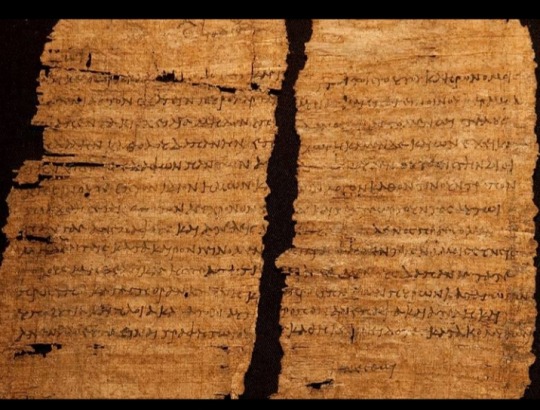
This papyrus signed by Cleopatra grants tax exemption from sales of imported wine to the Roman businessman Publius Canidius, a friend of Mark Antony.
At the bottom, in a rare example of her handwriting, Cleopatra herself added the Greek word "ginesthoi," which means "make it happen."
—
Cleopatra VII Thea Philopator (70/69 BC – 10 August 30 BC) was Queen of the Ptolemaic Kingdom of Egypt from 51 to 30 BC, and its last active ruler.
#Cleopatra#Mark Antony#Publius Canidius#Cleopatra VII Thea Philopator#Ptolemaic Kingdom#Egypt#Ancient Egypt
685 notes
·
View notes
Text







#acorigins#assassin's creed#assassin's creed origins#cleopatra#cleopatra vii thea philopator#ubisoft#photomode#gamingedit#virtual photography#gaming photography#in game photography#pc gaming#vgedit
14 notes
·
View notes
Text

Cleopatra VII, pharaoh
15 notes
·
View notes
Text




Plutarch's Lives in eleven volumes. Vol.9: Demetrius and Antony. Pyrrhus and Caius Marius
Cleopatra's grief over Mark Antony's suicide
#cleopatra#mark antony#plutarch#fragment#excerpts#on grief#history#ancient rome#roman empire#ancient egypt#shipping real people is a disease (( a disease that I have#marcus antonius#cleopatra VII philopator#cleopatra vii
18 notes
·
View notes
Text
Writing Notes: Rulers of the Ancient Greek World
The following abridged list of rulers for the ancient Greek world is primarily for the rulers of the Hellenistic age (323–31 B.C.), after the time of Alexander the Great. In the preceding centuries, the dominant geopolitical unit was the polis or city-state. Greek city-states were governed by a variety of entities, including kings, oligarchies, tyrants, and, as in the case of Athens, a democracy.
Rulers of Macedonia 496–168 B.C.
Alexander I 496–454 B.C.
Perdikkas II 454–413 B.C.
Archelaos I 413–399 B.C.
Aeropos II 398–395 B.C.
Amyntas II 395–394 B.C.
Amyntas III 393–370 B.C.
Perdiccas III 365–359 B.C.
Philip II 360/59–336 B.C.
Alexander III (the Great) 336–323 B.C.
Philip III Arrhidaios 323–317 B.C.
Alexander IV 323–310 B.C.
Olympias 317–316 B.C.
Cassander 315–297 B.C.
Philip IV 297 B.C.
Antipatros and Alexander V 297–294 B.C.
Demetrios I Poliorketes ("Besieger") 294–288 B.C.
Pyrrhos of Epeiros 288/7–285 B.C.
Lysimachos 288/7–281 B.C.
Seleukus 281 B.C.
Ptolemaios Keraunos ("Thunderbolt") 281–279 B.C.
Antigonos II Gonatas ca. 277–239 B.C.
Demetrios II 239–229 B.C.
Antigonos III Doson ca. 229–222 B.C.
Philip V 222–179 B.C.
Perseus 179–168 B.C.
The Ptolemaic Dynasty of Egypt 306–30 B.C.
Ptolemy I Soter ("Savior"; governor from 323) 306–282 B.C.
Ptolemy II Philadelphos ("Sister-friend") 284–246 B.C.
Ptolemy III Euergetes ("Benefactor") 246–222 B.C.
Ptolemy IV Philopator ("Father-friend") 222–204 B.C.
Ptolemy V Epiphanes ("[God] Manifest") 210–180 B.C.
Cleopatra I 180–177 B.C.
Ptolemy VI Philometor ("Mother-friend") 180–164, 163–145 B.C.
Cleopatra II 170–115 B.C.
Ptolemy VIII Euergetes II Physkon ("Potbelly") 170–163, 145–116 B.C.
Ptolemy VII Neos Philopator (with Ptolemy VI and briefly after the latter's death) 145–144 B.C.
Ptolemy IX Soter II Lathyros ("the Bean") 116–107, 88–81 B.C.
Cleopatra III 140–101 B.C.
Ptolemy X Alexander I 107–88 B.C.
Berenike III 100–80 B.C.
Ptolemy XI Alexander II 80 B.C.
Ptolemy XII Neos Dionysos Auletes ("the Piper") 80–58, 55–51 B.C.
Cleopatra V 80–69 B.C.
Berenike IV and Cleopatra VI 58–55 B.C.
Ptolemy XIII 51–47 B.C.
Cleopatra VII 51–30 B.C.
Ptolemy XIV 47–44 B.C.
Caesarion (Ptolemy XV) 44–30 B.C.
The Seleucid Dynasty, Rulers in Asia Minor 305–63 B.C.
Seleukos I Nikator ("Victor"; ruler from 312) 305–281 B.C. with Antichos I Soter 294 or 293–281
Antiochos I Soter 281–261 B.C.
Antiochos II Theos ("the God") 261–246 B.C.
Seleukos II Kallinikos ("the Glorious Victor") 246–226/5 B.C.
Seleukos III 226/5–223 B.C.
Antiochos III Megas ("the Great") 223–187 B.C.
Seleukos IV Philopator 187–175 B.C.
Antiochos IV Epiphanes 175–164 B.C.
Antiochos V Eupator ("of the Good Father") 164–162 B.C.
Demetrios I Soter 162–150 B.C.
Alexander Balas (Epiphanes) 150–145 B.C.
Demetrios II Nikator 145–140, 129–126/5 B.C.
Antiochos VI Epiphanes 145–142 B.C.
Diodotos "Triophon," pretender 142–139/8 B.C.
Antiochos VII Sidetes 139/8–129 B.C.
Kleopatra Thea ("Goddess") 126/5–123 B.C.
Antiochos VIII Grypos 126/5–96 B.C.
Seleukos V 126 B.C.
Antiochos IX Philopator "of Kyzikos" 114/3–95 B.C.
Seleukos VI 95 B.C.
Antiochos X Eusebes ("the Pious") Philopator 95 B.C.
Demetrios III Philopator Soter (at Damascus) 95–88 B.C.
Antiochos XI Epiphanes Philadelphos (in Cilicia) 95 B.C.
Philip I (in Cilicia) 95–84/3 B.C.
Antiochos XII Dionysos (at Damascus) 87 B.C.
Philip II 84/3 B.C.
Antiochos XIII Philadelphos 69–63 B.C.
The Attalids, Rulers of Pergamon 283–129 B.C.
Philetairos (not king) 283–263 B.C.
Eumenes I (not formally king) 263–241 B.C.
Attalos I Soter 241–197 B.C.
Eumenes II Soter 197–159/8 B.C.
Attalos II 159/8–139/8 B.C.
Attalos III 139/8–133 B.C.
Aristonikos ("Eumenes III") 133–129 B.C.
Rulers of Pontus ca. 280–63 B.C.
Mithridates I ca. 280–ca. 266 B.C.
Ariobarzanes ca. 266–ca. 255 B.C.
Mithridates II ca. 255–ca. 220 B.C.
Mithridates III ca. 220–ca. 185 B.C.
Pharnaces I ca. 185–ca. 170 B.C.
Mithridates IV Philopator ca. 170–ca. 150 B.C.
Mithridates V Euergetes ca. 150–120 B.C.
Mithridates VI Eupator, "the Great" ca. 120–63 B.C.
Rulers of Baktria 256–55 B.C.
Diodotos I 256–248 B.C.
Diodotos II 248–235 B.C.
Euthydemos I ca. 235–ca. 200 B.C.
Euthydemos II ca. 200–ca. 190 B.C.
Demetrios I ca. 200–ca. 185 B.C.
Antimachos I ca. 195–ca. 185 B.C.
Pantaleon ca. 185–ca. 180 B.C.
Demetrios II ca. 185–ca. 175 B.C.
Agathokles ca. 180–ca. 165 B.C.
Eukratides I (usurper?) ca. 171–ca. 155 B.C.
Agathokleia and Menandros ca. 155–ca. 130 B.C.
Kalliope and Hermaios ca. 75–ca. 55 B.C.
Source ⚜ More: Writing Notes & References ⚜ Writing Resources PDFs
#ancient greece#writing reference#writeblr#writers on tumblr#dark academia#spilled ink#history#writing prompt#creative writing#literature#light academia#writing ideas#writing inspiration#writing resources
60 notes
·
View notes
Text
Friends, Romans, Countrymen, lend me your ears! The people have spoken, and the finale is set!
Marcus Tullius Cicero, former consul, great statesman, lawyer, scholar, philosopher, orator and writer,
vs.
Cleopatra VII Thea Philopator, Queen of the Ptolemaic Kingdom of Egypt!
Voting starts March 14th, so that the winner will be declared on the ides of March! Make sure to spread the word and show support for your champion - it might spare you from a treason trial!
31 notes
·
View notes
Text

On September 2nd, in 44 B.C. Cleopatra VII named her then three year old son by Caesar the King of Egypt and her co ruler. After Caesar’s murder on the infamous “Ides of March”, the Egyptian Royal Family had fled from Rome for their safety and returned home to Alexandria. Pregnant with their second child at the time of Caesar’s death, Cleopatra miscarried the child sometime during the flight or shortly after.
Her half brother/husband, Ptolemy XIV, died sometime after July 26, 44 BC, which is the date of the last known inscription that mentions him being alive. He would have been about 17 at the time, and of an age to take an active role in ruling, which is something Cleopatra wouldn’t have wanted. It is often thought, though un-proven, that she had the young Ptolemy killed so she could replace him on the throne with her son and Caesar’s only living biological child.
The new King was officially known as Ptolemy XV Philopator Philometor Caesar, with an additional set of Egyptian Names, though he most often went by the nickname of Caesarion. Because of his young age at the time, he was King in name only and his mother kept all real authority to herself
#cleopatra#cleopatra vii#caesarion#ancient egypt#ptolemaic dynasty#caesar#julius caesar#long live the queue
88 notes
·
View notes
Photo

Cleopatra & Antony
Regarded by the Romans as "fatale monstrum" – a fatal omen – Cleopatra is one of the ancient world's most popular, though elusive figures. The Egyptian queen has been immortalized by numerous writers and filmmakers, most popularly by William Shakespeare in Antony and Cleopatra, and by Hollywood in Cleopatra (1963), starring Elizabeth Taylor and Richard Burton. The latter work features the memorable image of the enticing young Cleopatra emerging gracefully from an unfurled carpet in front of Roman general Julius Caesar. But is Cleopatra to be regarded merely as the lover of Julius Caesar and Mark Antony? Or did she play an important role not only in the history of Egypt but also in that of the mighty Roman Republic?
Cleopatra VII Philopator ('father-loving') was born in January 69 BCE in the city of Alexandria, Egypt, the daughter of Ptolemy XII Auletes (117-51 BCE) and possibly Cleopatra V Tryphaena (c. 95 to c. 57 BCE). Cleopatra was to become the last monarch of the Ptolemaic Dynasty (established in 323 BCE after the death of Alexander the Great), ruling Egypt from 51 BCE to 30 BCE. In 48 BCE, Cleopatra had become an ally and lover of Julius Caesar and remained so until his assassination in Rome in March 44 BCE. The assassination of Julius Caesar threw Rome into turmoil, with various factions competing for control, the most important of these being the armies of Mark Antony (83-30 BCE) and Octavian (63 BCE to 14 CE), the former a supporter and loyal friend Caesar, the latter his adopted son.
Cleopatra Meets Antony
In 41 BCE, Cleopatra was summoned to Tarsus (in modern southern Turkey) by Mark Antony. She is said to have entered the city by sailing up the Cydnus River in a decorated barge with purple sails, while dressed in the robes of the Greek goddess Aphrodite. Antony, who equated himself with Dionysus, the god of wine in Greek mythology, was instantly won over. Much like the meeting between Cleopatra and Caesar, both sides saw something in the other that they needed. For Cleopatra, it was another opportunity to achieve power both in Egypt and in Rome; for Antony, the support of Rome's largest and wealthiest client states in his campaign against the might of the Parthians (Parthia was a region in modern north-eastern Iran) was highly desirable. At the meeting, Cleopatra allegedly requested that her half-sister Arsinoë, living in protection at the Temple of Artemis at Ephesus, be executed to prevent any future attempts on her throne. Antony and Cleopatra soon became allies and lovers, and he returned with her to Alexandria in 40 BCE.
In Alexandria, Cleopatra and Antony formed a society of "inimitable livers", which some historians have interpreted as an excuse to lead a life of debauchery, though it was more likely to have been a group dedicated to the cult of the mystical god Dionysus. In that year, Cleopatra bore Antony the twins Alexander Helios (the Sun) and Cleopatra Selene II (the Moon).
Continue reading...
53 notes
·
View notes
Text

Statue of Queen Cleopatra
Black basalt statue of Cleopatra VII Philopator, last active ruler of the Ptolemaic Kingdom of Egypt, 1st century BC.
Cleopatra VII Philopator is one of the most mesmerizing women in all of history. Born of a Ptolemy, she became queen at the early age of 17. She was highly educated in the full laws and customs of Egypt, Greece, and Rome, she engrossed herself in science, philosophy, women’s issues, and most impressive the native language of Egypt. She chose to link herself with Egypt by her dress, worship, and representation.
Now in the State Hermitage Museum, Saint Petersburg. ДВ-3936
Read more
368 notes
·
View notes
Text

Capisce✨🤌✨
One of the greatest love stories is alive in my DNA, in my heart and in my soul.
Who did Cleopatra love more?
Caesar or Mark Antony?
Some even venture and say Rome
Yet that was not her home and she was far too exotic, educated and Bold for Rome!!!
✨CLEOPATRA LOVED EGYPT 🇪🇬 4ever in my ❤️✨7 reasons why✨why ask why…
Cosplay Love? Nah this is reincarnate, fate , destiny, infinitely GREAT.

Cleopatra VII Thea Philopator…
“Give me my robe. Put on my crown. I have Immortal longings in me." --Act V. Cleopatra & Antony by William Shakespeare
13 notes
·
View notes
Text

Cleopatra
Artist: Gavin Hamilton (English, 1723-1798)
Date: ca. 1767-1769
Medium: Oil on canvas
Collection: Detroit Institute of Arts, Detroit, MI, United States
Cleopatra
Cleopatra VII Thea Philopator (70/69 BC – 10 August 30 BC) was Queen of the Ptolemaic Kingdom of Egypt from 51 to 30 BC, and the last active Hellenistic pharaoh. A member of the Ptolemaic dynasty, she was a descendant of its founder Ptolemy I Soter, a Macedonian Greek general and companion of Alexander the Great. Her first language was Koine Greek, and she is the only Ptolemaic ruler known to have learned the Egyptian language, among several others. After her death, Egypt became a province of the Roman Empire, marking the end of the Hellenistic period in the Mediterranean, which had begun during the reign of Alexander (336–323 BC).
#cleopatra#painting#oil on canvas#queen of the ptolematic kingdom of egypt#hellenistic pharaoh#ptolemaic dynasty#ancient history#historical art#fine art#oil painting#artwork#nude figure#curtains#drapery#queen of egypt#ancient egypt#english culture#english art#gavin hamilton#english painter#european art#18th century painting#detroit institute of arts
14 notes
·
View notes
Text

#acorigins#ac origins#assassin's creed#assassin's creed origins#cleopatra#cleopatra vii thea philopator#ubisoft#photomode#gamingedit#gaming photography#virtual photography#pc gaming#in game photography#vgedit
9 notes
·
View notes
Text
“i’m confused are you Cleopatra VII or Cleopatra VIII” i’m actually both. i am the reincarnation of Cleopatra VII Thea Philopator Ptolemy but in this reincarnated form i am known as Cleopatra VIII heiress of Alexander heiress of Zeus conqueror of rome faithful of olympus mother of the nile milk-giver of humanity rightful empress of the world. hope this helps💕
31 notes
·
View notes
Text

The Hunt: Cleopatra’s Long-Lost Tomb
The Egyptian queen may rest in the ancient city of Alexandria, which now lies at the bottom of the Mediterranean.
She has one of the most captivating and enduring mythologies of any leader in history, yet the true end of Queen Cleopatra’s story remains an enigma. Archaeologists might be able to offer some clarity, if they could only find her final resting place.
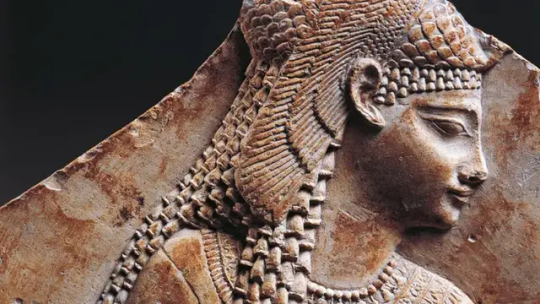
The location of the Queen of the Nile’s tomb has eluded experts for centuries. Napoleon famously led an expedition searching for the crypt in the early 19th century. Egyptologists widely believe it is hidden somewhere in Alexandria, where the missing tombs of all 14 of the Ptolemaic Pharaohs, the final dynasty of ancient Egypt, are expected to be. Alas, much of ancient Alexandria now lies at the bottom of the Mediterranean Sea.
Greek historian Plutarch indicated that when Emperor Octavian ended a civil war by defeating Cleopatra and her beloved husband, the great Roman general Mark Antony, he allowed for them to be buried together. Though the prospect of finding both of their physical remains is thrilling, Plutarch wrote of their death and burial several decades after their occurrence, which casts his words into doubt.

Many Egyptologists accept that both the Queen and her royal consort died dramatically by suicide, she by snakebite and he by his own sword. Others speculate that she died by intentional drug overdose, or by stinging herself with a poison-tipped hairpin. A growing number of experts suspect the suicide is a cover-up—that perhaps the queen was murdered. Much of the contemporary understanding of Cleopatra is based on the accounts of ancient Roman and Greek historians who undoubtedly held a bias towards her. An autopsy of her mummy might reveal different truths.
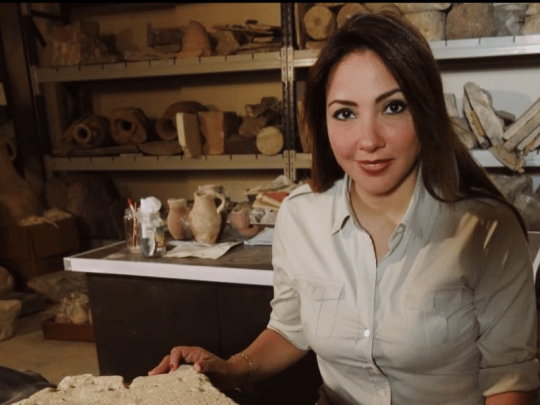
Dominican archaeologist Kathleen Martinez.
Today, the quest for Cleopatra VII Thea Philopator’s elusive burial place has been taken on primarily by Dominican archaeologist Kathleen Martinez, who has dedicated two decades of her life to this mission. Martinez subscribes to the snakebite ending. She believes the ancient queen’s suicide was a ceremonial act, part of a ritual apotheosis: shedding her mortal coil so as to ascend to the status of goddess. The ritual, Martinez theorizes, culminated in moving Cleopatra’s body from her palace to a temple 25 miles west of Alexandria, Taposiris Magna.
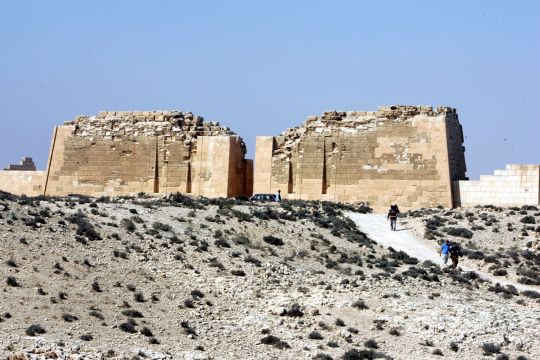


In 2022, Martinez announced the discovery of a tunnel running under the temple that she believes could have served as a corridor for delivering Cleopatra’s body. The tunnel is widely agreed to be an aqueduct, an exact replica of a similar structure found in Greece.
After working with Martinez for 11 years at Taposiris Magna, Zahi Hawass, former Minister of State for Antiquities Affairs of Egypt, now categorically disagrees with her. For one, it would be incredibly anomalous for a pharaoh to be interred at a temple. Furthermore, he asserts that there is “no evidence at all” to indicate that Cleopatra, ancient Egypt’s last pharaoh, is buried there.
“I believe now that Cleopatra was buried in her tomb that she built next to her palace and it is under the water,” Hawass lamented. “Her tomb will never be found.”
By Adnan Qiblawi.

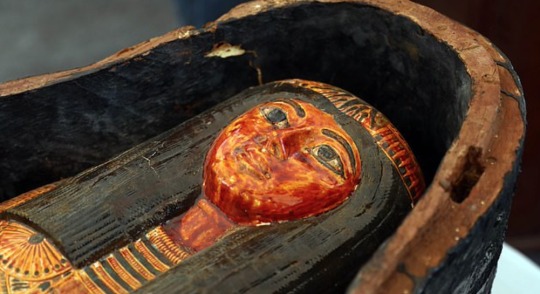
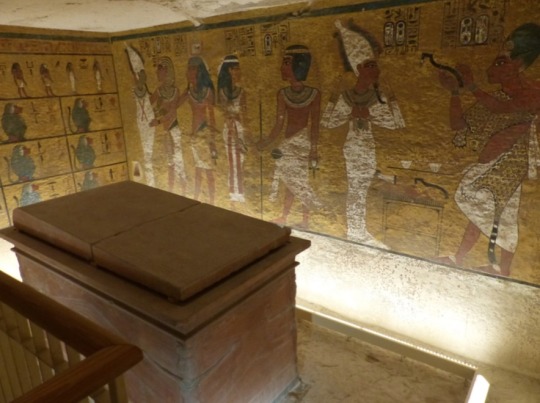
#The Hunt: Cleopatra’s Long-Lost Tomb#Queen Cleopatra#Egyptian Queen#Mark Antony#Taposiris Magna#ancient city of Alexandria#Kathleen Martinez#ancient grave#ancient tomb#ancient artifacts#archeology#archeolgst#history#history news#ancient history#ancient culture#ancient civilizations#ancient egypt#egyptian history#egyptian pharaoh
44 notes
·
View notes
Text
Quick reminder that Gaius Julius Ceasar invented being a power bottom and Cleopatra VII Thea Philopator invented being a girl boss
16 notes
·
View notes